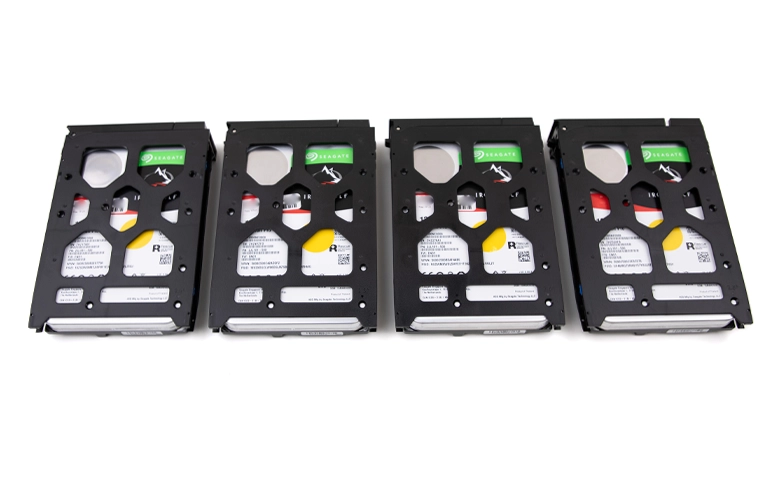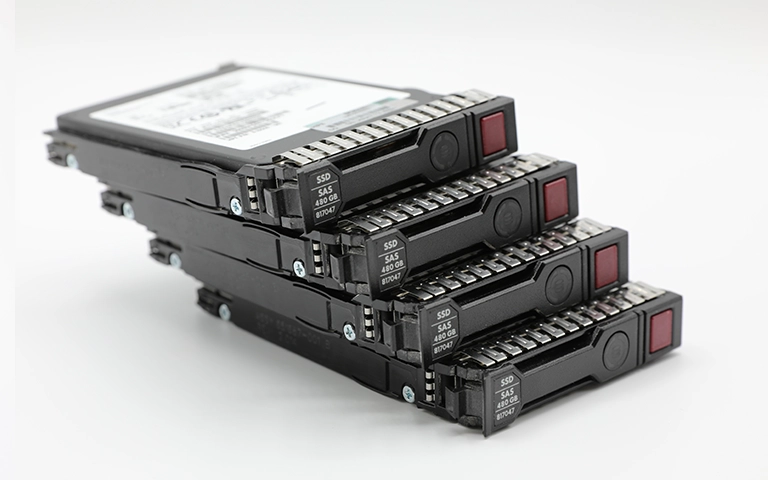Modern storage platforms depend on efficient communication between the operating system and attached drives. Two common modes that govern this interaction are AHCI (Advanced Host Controller Interface) and RAID (Redundant Array of Independent Disks).
Although both apply to SATA-based drives, they fulfil different roles. AHCI is built to maximise performance and compatibility for single-drive setups, enabling features such as Native Command Queuing and hot-swap. RAID focuses on redundancy, fault tolerance, and multi-drive configurations that protect data and improve throughput.
Understanding the differences between AHCI and RAID is critical when configuring or upgrading a workstation, server, or enterprise storage stack.
In this article, we explain how each mode operates, compare the benefits and trade-offs, and help you decide which configuration best fits your system requirements.

What Is AHCI (Advanced Host Controller Interface)
AHCI is a technical standard from Intel that defines how SATA storage devices communicate with a system’s motherboard. It was created to unlock the full capabilities of modern SATA, delivering faster and more efficient data transfers than legacy IDE modes.
A key feature of AHCI is Native Command Queuing (NCQ), which lets the drive reorder read and write commands to improve throughput. AHCI also supports hot swapping, so you can connect or remove drives without shutting the system down.
This mode suits desktops, laptops, and workstations that use a single hard drive or SSD, providing quick access times and broad compatibility with current operating systems. AHCI is also widely implemented in enterprise-grade SATA drives, as discussed in our post on Enterprise Hard Drive.
In summary, AHCI boosts performance and convenience, but it does not add redundancy or protect against drive failure.

What Is RAID (Redundant Array of Independent Disks)
RAID is a storage method that combines multiple physical drives into a single logical unit. The goal is to improve reliability, speed, or both, depending on how the array is configured.
Unlike AHCI, which manages a single drive, RAID distributes or mirrors data across several disks. Common RAID levels include:
RAID 0. Stripes data across drives to maximise performance, with no redundancy.
RAID 1. Mirrors data to two drives, protecting against a single drive failure.
RAID 5. Uses striping with parity to balance speed and fault tolerance.
RAID 10. Combines mirroring and striping to deliver both high performance and resilience.
These configurations help reduce downtime and minimise data loss in both personal and enterprise environments. Learn more about RAID fundamentals in our detailed post on What Is RAID in Computers.
RAID is widely used in servers, NAS platforms, and data centres where uptime and data integrity are critical requirements.

AHCI vs RAID – Key Differences
Although AHCI and RAID both govern how drives communicate with the system, they work in very different ways. AHCI focuses on optimising performance and compatibility for single SATA drives. RAID delivers redundancy and higher reliability by spreading or mirroring data across multiple drives.
Here is a detailed comparison:
Different RAID levels, including 0, 1, and 5, expand the flexibility of RAID for both performance and resilience. You can explore these configurations in our guide on Types of RAID.
Advantages of AHCI Mode
AHCI is a strong option for individual users and smaller deployments thanks to its simplicity and performance benefits for SATA drives. Key advantages include:
Native Command Queuing (NCQ): Optimizes read and write commands, enhancing data throughput and reducing latency.
Hot Swapping Support: Allows users to connect or disconnect drives without restarting the system, improving convenience and uptime.
Broad Compatibility: Works seamlessly with modern operating systems and SATA-based storage devices.
Improved SSD Performance: Enables advanced features that allow SSDs to operate more efficiently, especially in single-drive setups.
Simplified Setup: AHCI mode requires no additional configuration or controllers, making it ideal for users seeking a straightforward storage option.
Keep in mind that while AHCI enhances transfer performance, it does not provide redundancy. Drives can still fail, and SSDs in AHCI mode may experience issues such as reduced write speeds or firmware-related slowdowns.
Advantages of RAID Mode
RAID mode delivers benefits that suit users who prioritise data protection, performance, and uptime. By aggregating multiple drives into a single array, RAID provides redundancy and higher transfer speeds that AHCI cannot match.
Key advantages include:
Data redundancy. Levels such as RAID 1 and RAID 5 mirror data or store parity so recovery is possible if a single drive fails.
Improved read and write speed. RAID 0 and RAID 10 stripe data across multiple disks, increasing throughput and elevating overall system performance.
Scalability. Arrays can be expanded by adding drives, allowing capacity to grow in line with demand.
Fault tolerance. Parity-enabled configurations keep data accessible when a drive malfunctions, reducing downtime and operational risk.
Optimised for servers and enterprise systems. RAID is standard in business servers and large-scale storage where reliability and consistent performance are mandatory. Learn more about advanced setups in our post on RAID Configurations for Server.
Overall, RAID mode offers the flexibility and durability required for mission-critical environments.
Fast turnaround times for business-critical data
Which Mode Should You Choose?
Selecting between AHCI and RAID comes down to your hardware layout, performance targets, and resilience requirements. Both modes are valuable, but they serve different scenarios.
Choose AHCI if you run a single SSD or HDD and want better performance without additional configuration. It is ideal for personal computers, laptops, and small workstations that do not require redundancy.
Choose RAID if your system uses multiple drives and you need continuous uptime, data protection, or higher throughput. It is best suited to servers, NAS appliances, and enterprise environments that handle large datasets.
For multi-drive builds, you will also need to decide between software RAID and hardware RAID. Each offers different trade-offs in flexibility, cost, and speed. See our post on Software RAID vs Hardware RAID for a detailed comparison.
In summary, AHCI is simple and efficient for single-drive systems, while RAID provides the redundancy and performance required for critical applications where data loss is not acceptable.

Data Recovery in AHCI and RAID Systems
Both AHCI and RAID setups can suffer data loss, but the recovery path differs according to the root cause and architecture.
In AHCI mode, issues typically stem from firmware corruption, operating system errors, or gradual drive wear. Because AHCI governs a single disk, recovery focuses on acquiring a forensic image and repairing filesystem damage.
In RAID environments, failures are more complex and may involve multiple disk faults, controller errors, or incorrect rebuild attempts. Effective recovery requires virtual reconstruction of the array to restore logical access before safe extraction.
At RAID Recovery Services, our engineers specialise in both AHCI and RAID recoveries. We employ professional imaging workflows, advanced RAID reconstruction utilities, and ISO-certified cleanroom procedures to safeguard evidence and ensure complete, secure retrieval.
Even robust arrays can fail due to overlapping hardware faults or parity inconsistencies, as outlined in our RAID Failure Rate guide. Rapid escalation to specialists provides the highest likelihood of a successful outcome.
If your system shows signs of drive failure, corruption, or array degradation, contact RAID Recovery Services for an expert assessment and secure data restoration.

Trust the experts with proven results
Frequently Asked Questions
What is the main difference between AHCI and RAID?
AHCI enhances the performance of a single SATA drive by improving how the system communicates with the disk. RAID combines multiple drives to deliver higher speed, redundancy, or both. AHCI focuses on efficient communication, while RAID focuses on data protection and scalability.
Which mode is better for SSDs, AHCI or RAID?
For a single SSD, AHCI is usually preferable because it supports features such as Native Command Queuing and TRIM. If you are using multiple SSDs and need performance gains or redundancy, RAID is the better fit.
Can I switch from AHCI to RAID mode without losing data?
Switching modes can trigger boot errors or data loss if not handled correctly. Always create a full backup before changing BIOS settings. Professional assistance is recommended when converting between AHCI and RAID.
Does RAID replace the need for regular backups?
No. RAID reduces downtime and offers redundancy, but it does not protect against corruption, accidental deletion, or malware. You still need a robust backup strategy.
Can data be recovered from failed AHCI or RAID drives?
Yes. Data recovery professionals can retrieve information from failed drives in both AHCI and RAID setups. At RAID Recovery Services, our engineers manage both straightforward and complex recoveries with precision and confidentiality.